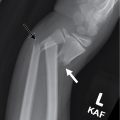Case presentation
A 20-month-old patient presents with decreased activity, including eating and drinking, over the past 2 days. He is currently completing a second course of oral antibiotics for acute otitis media and 1 week ago completed a 10-day course of cefdinir. He was especially sleepy today, per the parents, who decided to bring him to his primary care physician for evaluation. He was also found to have a temperature of 101 degrees Fahrenheit in the office. While en route to the office, the patient was noted to be staring ahead without interacting with his parents; he then developed right hand and arm twitching, which lasted for several minutes, then resolved. After the event, he has remained difficult to arouse. The parents state that he is an otherwise healthy child who has all of his recommended immunizations. They deny any possibility of ingestion or trauma.
His physical examination in the emergency department reveals an afebrile child who is in no acute distress but is quite sleepy and difficult to awaken. He has a heart rate of 130 beats per minute, a respiratory rate of 25 breaths per minute, and a blood pressure of 90/60 mm Hg; his oxygen saturation is 95% on room air. He has no signs of obvious trauma. His pupils are 3 mm, equal and reactive; he appears to have photophobia. His tympanic membranes and oropharynx are all clear. His cardiovascular and abdominal examinations are unremarkable. It is difficult to conduct a neurologic examination due to the child’s sleepiness, but he is moving all of his extremities, and grossly, the tone and strength appear to be equal. There are no skin lesions or rashes.
Imaging considerations
Patients with suspected intracranial pathology often undergo neuroimaging as part of a medical evaluation.
Computed tomography (CT)
Non–contrast-enhanced CT is an imaging test often utilized in patients with concerns for intracranial pathology. In its initial stages, cerebritis appears as an area of low attenuation; edema may be present. If intravenous contrast is used, CT may show patchy enhancement. CT is widely available and has the advantage of rapidity, usually obviating the need for sedation. However, CT does expose the patient to ionizing radiation.
Initially, CT in patients with cerebritis may appear normal. As the process progresses, a poorly defined area of cortical or subcortical hypodensity may be noted, accompanied by edema and mass effect of varying degrees. As the disease progresses, a better defined area of hypodensity with some ring enhancement may be seen.
Magnetic resonance imaging (MRI)
MRI is more sensitive than CT in the detection of early changes seen in cerebritis. In early cerebritis, MRI will demonstrate iso- or hypointense signals on T1-weighted imaging; T2-weighted signal imaging or fluid attenuated inversion recovery (FLAIR) sequences will demonstrate increased signal intensity and vasogenic edema. Late-stage cerebritis on MRI is demonstrated by progressive enhancement without obvious abscess.
Diffusion-weighted imaging can prove useful in the detection of cerebritis and subsequent brain abscess. On diffusion-weighted imaging, areas of cerebritis demonstrate restricted diffusion. Low diffusion coefficient values strongly suggest the presence of infection, including pus and abscess.
Imaging findings
The patient underwent non–contrast-enhanced cranial CT. A selected image from this study is provided. There is low attenuation in the left frontal lobe without evidence of hemorrhage ( Fig. 31.1 ).

Case conclusion
The results of the CT prompted MRI of the brain, with and without intravenous contrast. An MR arteriogram (MRA) and magnetic resonance venogram (MRV) were also obtained, since the CT findings can be attributed to an infectious or vascular process. Selected images are provided. The MRA/MRV studies were normal. The MRI demonstrated restricted diffusion, abnormal enhancement, and abnormal T2-weighted signal within the left frontal cortex, suggesting cerebritis ( Figs. 31.2 and 31.3 ).











